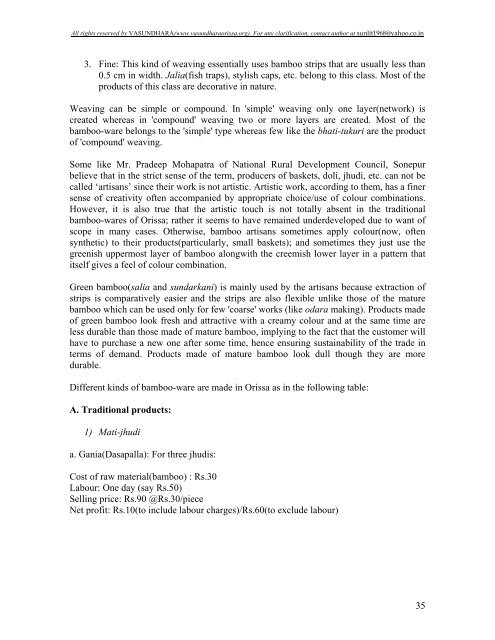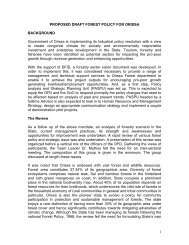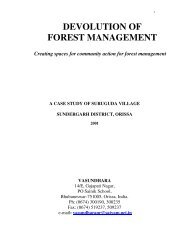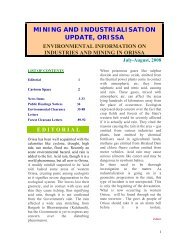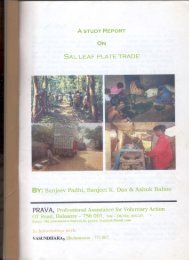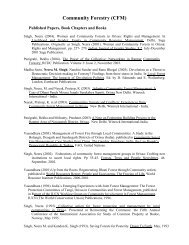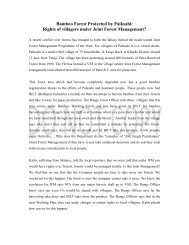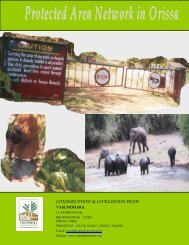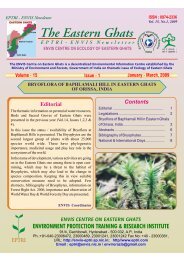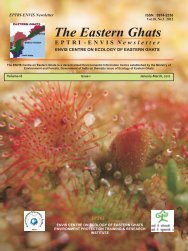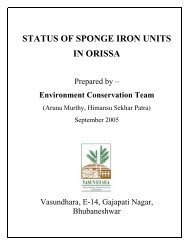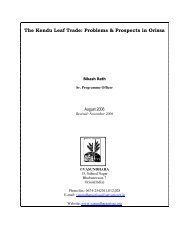Bamboo in Orissa: Trade and Livelihood Perspective - Vasundhara
Bamboo in Orissa: Trade and Livelihood Perspective - Vasundhara
Bamboo in Orissa: Trade and Livelihood Perspective - Vasundhara
Create successful ePaper yourself
Turn your PDF publications into a flip-book with our unique Google optimized e-Paper software.
All rights reserved by VASUNDHARA(www.vasundharaorissa.org). For any clarification, contact author at sunlit1968@yahoo.co.<strong>in</strong><br />
3. F<strong>in</strong>e: This k<strong>in</strong>d of weav<strong>in</strong>g essentially uses bamboo strips that are usually less than<br />
0.5 cm <strong>in</strong> width. Jalia(fish traps), stylish caps, etc. belong to this class. Most of the<br />
products of this class are decorative <strong>in</strong> nature.<br />
Weav<strong>in</strong>g can be simple or compound. In 'simple' weav<strong>in</strong>g only one layer(network) is<br />
created whereas <strong>in</strong> 'compound' weav<strong>in</strong>g two or more layers are created. Most of the<br />
bamboo-ware belongs to the 'simple' type whereas few like the bhati-tukuri are the product<br />
of 'compound' weav<strong>in</strong>g.<br />
Some like Mr. Pradeep Mohapatra of National Rural Development Council, Sonepur<br />
believe that <strong>in</strong> the strict sense of the term, producers of baskets, doli, jhudi, etc. can not be<br />
called ‘artisans’ s<strong>in</strong>ce their work is not artistic. Artistic work, accord<strong>in</strong>g to them, has a f<strong>in</strong>er<br />
sense of creativity often accompanied by appropriate choice/use of colour comb<strong>in</strong>ations.<br />
However, it is also true that the artistic touch is not totally absent <strong>in</strong> the traditional<br />
bamboo-wares of <strong>Orissa</strong>; rather it seems to have rema<strong>in</strong>ed underdeveloped due to want of<br />
scope <strong>in</strong> many cases. Otherwise, bamboo artisans sometimes apply colour(now, often<br />
synthetic) to their products(particularly, small baskets); <strong>and</strong> sometimes they just use the<br />
greenish uppermost layer of bamboo alongwith the creemish lower layer <strong>in</strong> a pattern that<br />
itself gives a feel of colour comb<strong>in</strong>ation.<br />
Green bamboo(salia <strong>and</strong> sundarkani) is ma<strong>in</strong>ly used by the artisans because extraction of<br />
strips is comparatively easier <strong>and</strong> the strips are also flexible unlike those of the mature<br />
bamboo which can be used only for few 'coarse' works (like odara mak<strong>in</strong>g). Products made<br />
of green bamboo look fresh <strong>and</strong> attractive with a creamy colour <strong>and</strong> at the same time are<br />
less durable than those made of mature bamboo, imply<strong>in</strong>g to the fact that the customer will<br />
have to purchase a new one after some time, hence ensur<strong>in</strong>g susta<strong>in</strong>ability of the trade <strong>in</strong><br />
terms of dem<strong>and</strong>. Products made of mature bamboo look dull though they are more<br />
durable.<br />
Different k<strong>in</strong>ds of bamboo-ware are made <strong>in</strong> <strong>Orissa</strong> as <strong>in</strong> the follow<strong>in</strong>g table:<br />
A. Traditional products:<br />
1) Mati-jhudi<br />
a. Gania(Dasapalla): For three jhudis:<br />
Cost of raw material(bamboo) : Rs.30<br />
Labour: One day (say Rs.50)<br />
Sell<strong>in</strong>g price: Rs.90 @Rs.30/piece<br />
Net profit: Rs.10(to <strong>in</strong>clude labour charges)/Rs.60(to exclude labour)<br />
35


